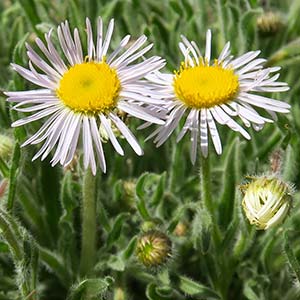|
Peck's threadleaf fleabane
|
Snake River fleabane, white cushion fleabane
|
| Perennial from a taproot and branched, short woody base, 1-5 dm. tall, the stem densely covered with fine, appressed hairs aligned in one direction. |
Perennial from a tap-root, 3-12 cm. high, the stem covered with very unequal, spreading hairs. |
Leaves both basal and cauline, linear or linear-filiform, 1-8 cm. long and 0.3-3 mm. wide, of uniform width. |
Leaves nearly all in a basal cluster, finely stiff-hairy, linear or linear-oblanceolate, up to 4 cm. long and 2 mm. wide. |
Heads solitary or several; involucre 4-6 mm. high, with fine, soft hairs or small glands or both; rays 15-125, blue, pink or white, 3-13 mm. long and 1-2 mm. wide; pappus of 20-30 simple hairs. |
Heads solitary; involucres 5-7 mm. high, with spreading short hairs and often glandular as well; rays 30-60, white, pistillate, becoming pinkish, 5-10 mm. long and 1.5-2.3 mm. wide; disk flowers yellow; pappus of 15-25 capillary bristles. |
|
|
|
|
| May-July |
May-July |
| Sagebrush plains, dry slopes, and grasslands. |
Dry, rocky hillsides at low to middle elevations. |
Occurring east of the Cascades crest and in the Columbia River Gorge in Washington; British Columbia to California, east to Montana, Idaho, and Utah.
|
Occurring east of the Cascades crest in the Snake River area in southeastern Washington; southeastern Washington to southeastern Oregon, east to southwestern Idaho.
|
| Native |
Native |
| Not of concern |
Sensitive in Washington (WANHP) |
E. acris, E. aliceae, E. annuus, E. aureus, E. basalticus, E. bloomeri, E. caespitosus, E. chrysopsidis, E. compositus, E. corymbosus, E. davisii, E. disparipilus, E. divergens, E. eatonii, E. elatus, E. flettii, E. glacialis, E. howellii, E. inornatus, E. karvinskianus, E. leibergii, E. linearis, E. lonchophyllus, E. nivalis, E. oreganus, E. peregrinus, E. philadelphicus, E. piperianus, E. poliospermus, E. pumilus, E. salishii, E. speciosus, E. strigosus, E. subtrinervis |
E. acris, E. aliceae, E. annuus, E. aureus, E. basalticus, E. bloomeri, E. caespitosus, E. chrysopsidis, E. compositus, E. corymbosus, E. davisii, E. divergens, E. eatonii, E. elatus, E. filifolius, E. flettii, E. glacialis, E. howellii, E. inornatus, E. karvinskianus, E. leibergii, E. linearis, E. lonchophyllus, E. nivalis, E. oreganus, E. peregrinus, E. philadelphicus, E. piperianus, E. poliospermus, E. pumilus, E. salishii, E. speciosus, E. strigosus, E. subtrinervis |
| |
BC,
CA,
OR,
WA
CalFlora,
CalPhotos,
Flora NW,
PNW Herbaria,
Turner Photog.
WildflowerSearch
iNaturalist (observations)
USDA Plants Database



